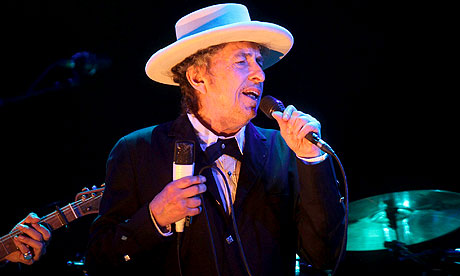 It’s been way too long since I’ve seen a Bob Dylan show – two years to the day according to my research. Moving, settling, being out of town when he was in town was part of it; Dylan was also touring a bit less with one U.S. tour a year instead of two.
It’s been way too long since I’ve seen a Bob Dylan show – two years to the day according to my research. Moving, settling, being out of town when he was in town was part of it; Dylan was also touring a bit less with one U.S. tour a year instead of two.
I was anxious to see his latest incarnation on stage, behind a baby grand piano instead of the electric keyboard he had been standing behind in recent years – both of them completely out of character for a man who was a troubadour for 50 years with a guitar, and who caused a cultural tidal wave when he switched preference from acoustic to electric.
I had all kinds of theories for the keyboard – he had a back pain that meant he couldn’t sling a guitar on every night any more; being behind a keyboard was an easier way to see lyric cue cards, something like that. T Bone Burnett told me he probably did it just to confound everyone.
But his splendid show Tuesday at the Verizon Center in Washington, D.C., I finally figured it all out: He’s moving to all these different instruments because he’s still learning things at 71 and eager to see how piano colors these towering and indelible songs he’s been playing so long.
He’s always brought something different to his material, evolving songs that fans would have long ago embalmed into organic entities, unexpected waltzes, inventive blues variations with stinging patterns, always with the odd, often barking emphasis on the words – the words being, finally, the only way each song could be identified.
But on piano, there was a richness as he brought a gospel scale to many songs and once again led his band (he seemed to have let the guitarists lead the songs when he was on the comparatively inaudible electric keyboard). Best of all his voice was nuanced and expressive and carried well in the arena especially at the beginning and end of his set.
It’s the end of the tour, which is closing in Brooklyn tomorrow, and means that he’s by now incorporated the talent of opener Mark Knopfler into the set. Knopfler, who opened what was obviously a co-headlining show with his own solid set, In the same way as Dylan’s band is ramshackle and driving, Knopfler’s approach is precise and more pure, breaking down several of the melodic songs into the quite Celtic basics, with fiddle and flute, before building them up again. When he joined Dylan during his set, he almost snuck on stage alongside Stu Kimball and Charlie Sexton, to take lead on “To Ramona” and be part of the string interplay on “Tangled Up in Blue.”
But the song that really delivered was a version of “Things Have Changed” with Dylan standing in front of the band, diving and crouching at the microphone, free of any instrument but a harmonica, punching the words and punching Knopfler’s arms as the guitarist added his own tasteful electric flourishes to a much more intense version. It should either be released as a new live version or at least be captured in a video before the tour ends this week.
Though Knopfler has a long history with Dylan, notably being the producer and guitarist on “Infidels” (and the two songs from that session that were arguably more important, “Blind Willie McTell” and “Foot of Pride”), no songs from that era was played.
But there was a bit of history made in the show, as he performed the light, 50s style “Soon After Midnight” live for the first time. It was also the first time he has played two songs from the latest album “Tempest” at a single show. When the North American tour began a month before his new album came out, there were no songs from it featured in the live shows. By now, he has performed four different “Tempest” songs live so far, and the other one Tuesday that’s earned a permanent place on the tour is the snarling “Early Roman Kings,” and its familiar electric blues riff.
Just about everything in the show was a highlight, from the easy going opener of “I’ll Be Your Baby Tonight” (without the recorded fanfare or oddball announcer’s spoken intro), and an unexpected “Chimes of Freedom.”
It was great, too, to see the care taken with what might be understandably by now throwaways, resulting in a powerful “Ballad of a Thin Man,” a still effective “Like a Rolling Stone” and a driving “All Along the Watchtower,” making way for a really sweet acoustic and heartfelt version of “Blowing in the Wind” in the encore.
Taking into account Dylan’s age, one must consider how lucky it is for fans to have the influential writer and performer still on the road, triggering an early thanksgiving.
One must wonder though: How much longer can we expect to see these annual tours? Not that he has any indication of slowing down.
Still, I don’t think I’ll go two years without a show if I have the opportunity.